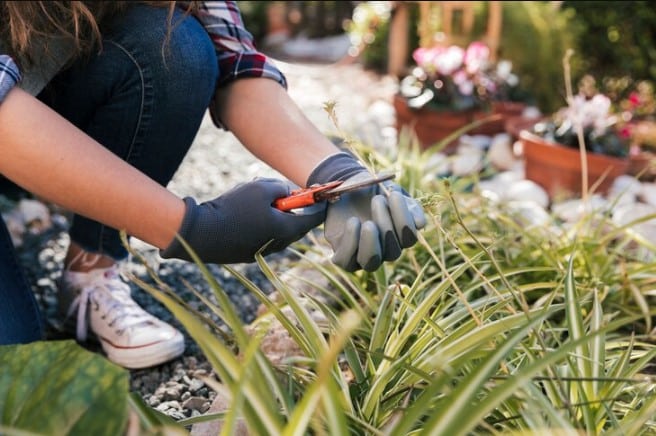With the world becoming more ecologically conscious, people are looking for sustainable and eco-friendly choices for residential landscaping in Sydney. One such solution is xeriscaping. An alternative to traditional landscape construction in Sydney, xeriscaping is a landscaping approach that minimises water usage and promotes using drought-tolerant plants.
In this blog, you will understand everything about xeriscaping – its meaning, benefits, the types of plants you can use, and some design ideas for building a yard.
Understanding Xeriscape Landscaping
Xeriscaping is a sustainable landscaping practice. It focuses on minimising the need for water while maintaining a visually appealing garden or yard. The term “xeriscape” comes from the Greek word “xeros,” which means “dry.” It emphasises landscaping with plants that can thrive with little to no irrigation, thereby promoting water conservation.
Xeriscaping uses drought-tolerant plants, efficient irrigation methods, and landscape designs prioritising water conservation. This approach is great for easy landscape maintenance in Sydney as it creates low-maintenance yards that require little to no irrigation and can thrive even in arid or semi-arid climates.
Xeriscaping involves careful planning and design to ensure that the chosen plants and landscaping features work together harmoniously. It typically includes the use of mulches, native plants, and efficient watering techniques such as drip irrigation to make the most of available water resources.
Benefits of Xeriscaping and Why You Should Consider It
- Water-Efficient Landscaping
By using drought-resistant plants and efficient irrigation systems, xeriscaping can reduce water usage significantly. This is especially important in regions where water scarcity is a concern.
- Eco-Friendly Gardening
Xeriscaping uses native and drought-tolerant plants, which require fewer resources like fertilisers and pesticides. This approach supports local ecosystems and reduces environmental impact.
- Low-Maintenance Yards
With xeriscaping, you can spend less time and effort maintaining your yard. Drought-tolerant plants need less water and care, making your outdoor space easier to manage.
- All-Natural
Xeriscaping encourages the use of organic mulch and native plants, which contribute to healthier soil and support biodiversity in gardens.
- Creating a Wildlife Habitat
By choosing native plants, you provide food and shelter for local wildlife, such as birds and insects. This can create a more vibrant and diverse ecosystem in your yard.
Choosing the Right Plants
Selecting the right plants is essential for successful xeriscaping. You may get professional help from gardening services in Sydney or personally choose the plants for your yard. Remember to pick drought-resistant plants that will thrive in your region’s climate.
Here are some plant options for your xeriscaped yard:
Trees: Consider trees such as desert willow, crepe myrtle, or palo verde. These trees are known for their drought tolerance and can add height and shade to your landscape. Other options include mesquite, olive, and acacia trees.
Shrubs: Drought-tolerant shrubs like lavender, rosemary, and agave can add colour and texture to your garden. They’re also known for their low water requirements. You can also consider oleander, juniper, and barberry for their resilience and versatility.
Ground Covers: Ground covers such as sedum, ice plant, and thyme are excellent choices for covering large areas while conserving water. They provide ground-level coverage, reduce soil erosion, and add visual interest to your landscape.
Perennials: Perennial plants like yarrow, coneflower, and black-eyed Susan offer vibrant blooms year after year with minimal water requirements. These plants can provide seasonal interest and attract pollinators.
Xeriscape Design Ideas
If you’re considering xeriscape ideas for your yard, here are some design ideas to discuss with your landscapers in Sydney.
- Water-Saving Designs
Create natural slopes or contours in your yard to channel rainwater to plants. This will reduce the need for irrigation and ensure plants receive adequate moisture.
- Sustainable Backyard Designs
Incorporate permeable surfaces such as gravel or wood chips to allow water to filter through to the soil. This can help prevent soil erosion and improve soil health.
- Gravel Gardens
Using gravel as a ground cover can reduce water evaporation and help retain soil moisture. Gravel gardens also add a modern and stylish touch to your outdoor space.
- Use Pavers
Replace traditional lawns with pathways and patios made of pavers or stepping stones. This reduces the amount of water needed to maintain a lawn and adds visual interest to your yard.
- Raised Beds
Raised garden beds allow you to control soil composition and drainage, making it easier to grow a variety of plants efficiently. Raised beds can also help prevent water runoff and soil erosion.
- Rain Gardens
Incorporate rain gardens to capture and filter rainwater, which can then be used to water your xeriscaped plants. Rain gardens can be both functional and beautiful, enhancing the overall aesthetic of your yard.
- Native Plant Groupings
Grouping native plants together based on their water and sunlight needs can create a harmonious landscape that thrives with minimal irrigation. This approach mimics natural ecosystems and helps your plants grow more effectively.
Conclusion
Adopt the xeriscaping approach for your residential garden maintenance and enjoy multiple benefits, from conserving water to creating a beautiful and sustainable outdoor space. Choose drought-tolerant plants and incorporate efficient landscape designs to create an eco-friendly, low-maintenance yard.
With the right plant choices and thoughtful xeriscape design, your yard can become a sustainable and beautiful space that you can enjoy for years to come. If you need help with xeriscaping ideas or irrigation installation in Sydney for your home, contact us today.

